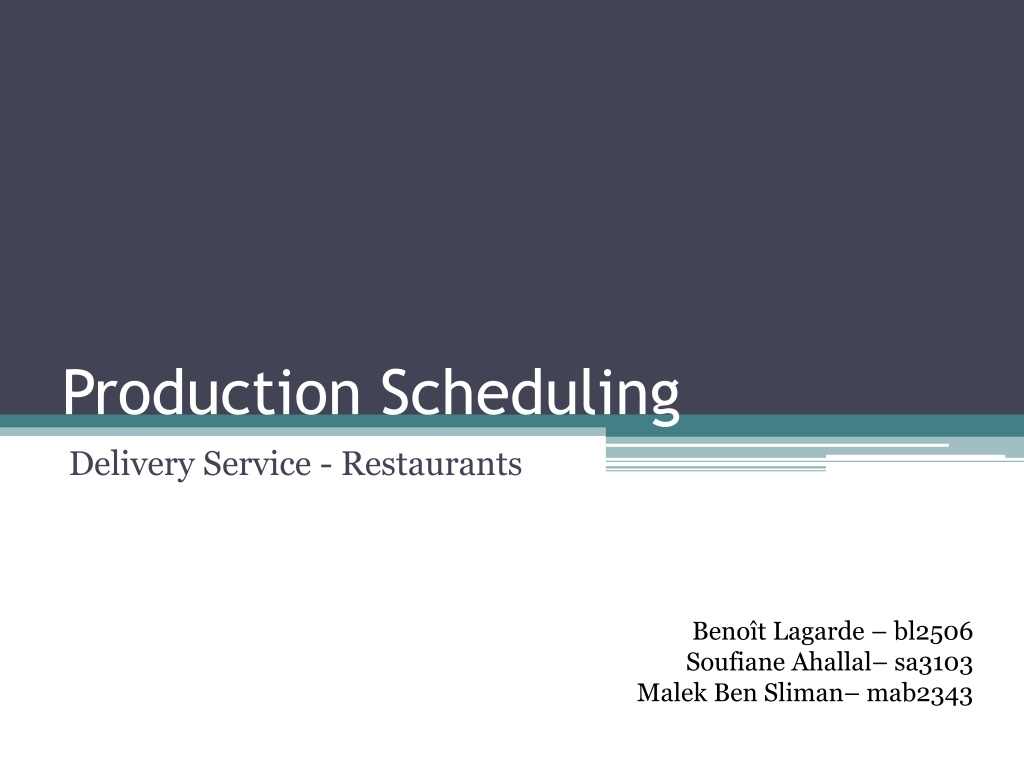Production Scheduling & Delivery Service for Restaurants
The project focuses on optimizing delivery services for multiple restaurants by centralizing the fleet of delivery personnel. It looks into reducing customers' waiting time and cutting down delivery costs by implementing a unique system for all restaurants. The algorithm, simulation, and results are presented to showcase the efficiency of the proposed approach.
Download Presentation

Please find below an Image/Link to download the presentation.
The content on the website is provided AS IS for your information and personal use only. It may not be sold, licensed, or shared on other websites without obtaining consent from the author.If you encounter any issues during the download, it is possible that the publisher has removed the file from their server.
You are allowed to download the files provided on this website for personal or commercial use, subject to the condition that they are used lawfully. All files are the property of their respective owners.
The content on the website is provided AS IS for your information and personal use only. It may not be sold, licensed, or shared on other websites without obtaining consent from the author.
E N D
Presentation Transcript
Production Scheduling Delivery Service - Restaurants Beno t Lagarde bl2506 Soufiane Ahallal sa3103 Malek Ben Sliman mab2343
2 Agenda I- Background II- Algorithm III- Simulation & Results
3 I- Background 1) The problem Questions: - How can we decrease customers waiting time? - How can we decrease costs of delivery? Current situation: - A restaurant owner owns N restaurants - Each restaurant has its own fleet of delivery men and each faces problems with their delivery service. The idea: Centralize delivery by only having a unique fleet of deliverymen that would work for the whole network of restaurants
4 I- Background 2) Inputs Average Restaurant: - Frequency: 50 orders/lunch (Normal Distribution over lunch) - Nb of delivery men: 3 delivery men - Cooking time: 18 minutes Distances from a restaurant to its customers P(X<d) for d straight distance in miles 1.0000 0.9000 0.8000 0.7000 0.6000 0.5000 0.4000 0.3000 0.2000 0.1000 0.0000 0.0 0.5 1.0 1.5 2.0
5 II- Algorithm How it works Input: Number of restaurants, number of simulations, number of delivery men for each case (centralized and decentralized), restaurant locations Process: Model 1: Decentralized Generate Orders Outputs Model 2: Centralized - rj: time of order - Cj= rj+CT+ travel time - - rj: time of order (xi, yi): customers coordonates
6 II- Algorithm How it works Models: At each unit of time t Update Customers List (rj, Cj) Outputs Assign a delivery man Update delivery men positions YES Order at t? NO Update delivery men positions
7 III- Simulation & Results 1) Simulation Scenarios: - Same number of delivery men: How does it impact the waiting time? - Fewer delivery men: How much can we decrease the number of delivery men while keeping the same average waiting time? Parameters - Different restaurant densities: 1 restaurant/ 0.1 mile, 0.3 mile and 0.5 mile - Different number of restaurants: 4, 9, 16 and 25 restaurants (on a square 3x3 ) - Average on 3000 simulations
8 III- Simulation & Results 2) Results Delivery ONLY Same # drivers Mean(Lj) 60.0% 55% 55.0% 50.0% 45.0% 40.0% Low Density 35.0% Medium Density High Density 30.0% 25.0% 20.0% 15.0% 10.0% 0 5 10 15 20 25 30
9 III- Simulation & Results 2) Results Delivery ONLY Same # drivers Variance(Lj) 90.0% 87% 85.0% 80.0% 75.0% 70.0% Low Density Medium Density 65.0% High Density 60.0% 55.0% 50.0% 45.0% 0 5 10 15 20 25 30
10 III- Simulation & Results 2) Results Delivery ONLY Lower # drivers - Still 33% improvement of the variance 20.0% 19% 18.0% 16.0% 14.0% Low Density 12.0% Medium Density High Density 10.0% 8.0% 6.0% 4.0% 0 5 10 15 20 25 30
11 Conclusion It works pretty well: Improvement Comments Average delivery time (travel) More deliveries possible & better service 55% Lower number of angry customers Variance 85% Cut costs with a better variance Fewer delivery men 20% Same number of delivery men Lower number of delivery men To go further: Have a more complex model: - More than 1 order/ delivery man - Possibility to take orders from different restaurants at the same time - When a delivery man is free, where to go (not to the closest restaurant) - Stochastic Parameters: cooking time, travel time, number of orders
12 Thank you!























